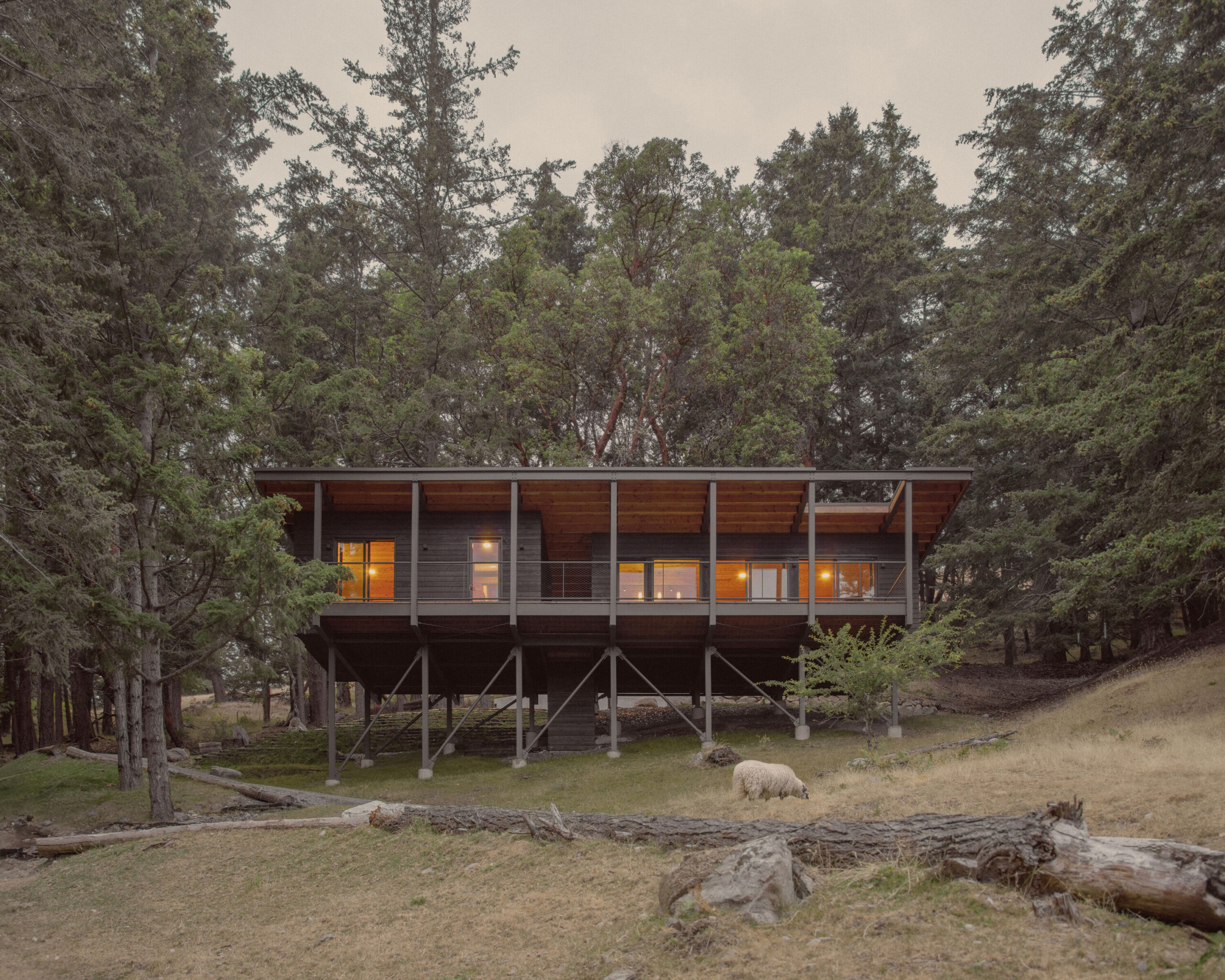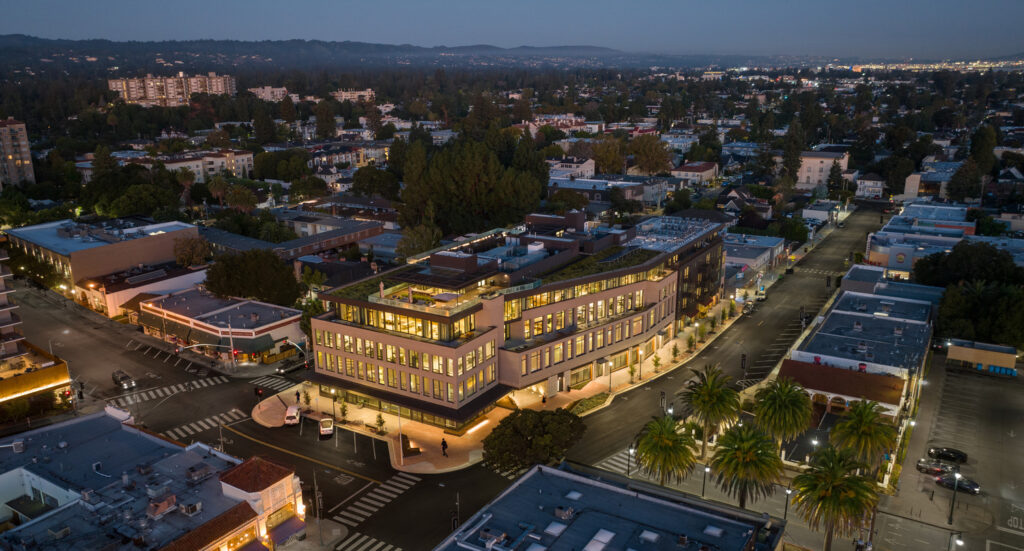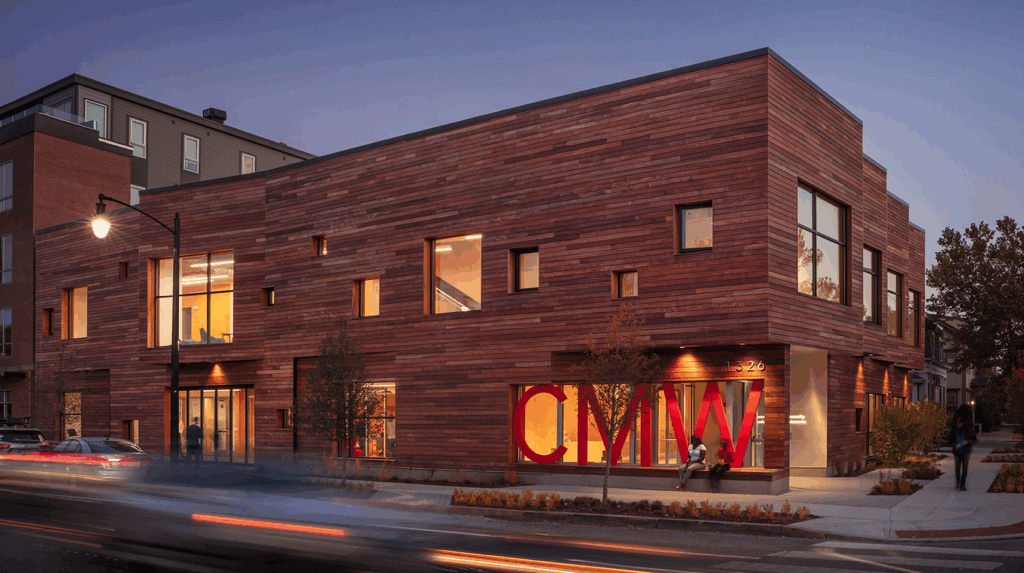Hospitality, Light-Frame Construction, Mass Timber
Hip Hotel Tackles Taxing Terrain with Mass Timber
Faced with a formidably steep site, Skylab turned to prefab mass timber and on-site light-frame construction for the Humbird Hotel in Northern Idaho. The result is a meticulously designed 31-room, three-story boutique mountain resort that refines the alpine vacation experience by paying attention to details—big and small. This hybrid timber solution was not only well-suited to the project’s challenging locale, but reflects the area’s heritage, once the site of a working forest and sawmill.
Humbird at Schweitzer
Turning Around Tough Projects with Mass Timber
Meeting challenging site constraints with mass timber has become a bit of a forte for Oregon-based Skylab—a firm that cut its teeth on daunting design dilemmas. “We are often called on to tackle demanding commissions on tight or steeply sloping sites—and to come up with one-of-a-kind solutions in the face of some extreme conditions,” explains Brent Grubb, principal and cofounder for the firm.
Such was the case with the highly publicized Hoke House, a niche residential project that makes the most of a small buildable area with its daringly cantilevered, wood-built design—subsequently featured in the Twilight movie series. Commercially, the firm took on a similar challenge when it transformed an awkwardly orphaned parcel of land in downtown Portland into a vibrant five-story mixed-use property, Sideyard, by way of cross-laminated timber (CLT) and mass plywood.
Grubb and his team again turned to innovative massing and prefabricated hybrid mass timber building systems when faced with an arduously narrow alpine site for Schweitzer’s signature ski-in-ski-out boutique hotel.

Humbird at Schweitzer | Exterior
Timber Triumph: Doing the Most With a Challenging Site
At Humbird Hotel, wood construction provided an opportunity to tell a story through wood that reflects the area’s heritage, Grubb explains.

Humbird at Schweitzer | Exterior
The hotel’s moniker, Humbird, refers to a former lumber mill that helped build the area in the early 1900s—at one point becoming the largest sawmill in the region and owning over 200,000 acres of forestland.
But the mass timber and light-frame combo also helped solve some unique design problems, he adds. “Timber was not just a material choice for the project; it was a catalyst for the entire design process,” he says.
One of the biggest challenges was the building’s location—an awkward, angular site with a steep grade, situated among a disparate group of older buildings. “But, we really made the site work in favor of the project,” Grubb says. “Considering its slope, we designed a building that bridges the steep gradient with a concrete foundation, transitioning into a timber structure above.”
The barbell-shape building takes advantage of the elevation by nestling into a notch cut into the slope. “This approach allowed us to anchor the building into the hillside while embracing timber for its aesthetic appeal and structural capabilities in the upper sections,” Grubb says.
The hotel’s placement among adjacent existing buildings that remain makes it the centerpiece of a newly invigorated, European-style mountain village, connected by narrow walkable streets. Positioned at the entrance to Schweitzer Mountain, it establishes a pedestrian-only plaza space, with the lobby and welcome area situated atop below-grade parking. Once parked, guests can forgo their vehicles and ski to and from the lifts.

Humbird at Schweitzer | Exterior

Humbird at Schweitzer

Humbird at Schweitzer
Star-Studded Structure: Playing to Wood’s Strength
It’s a design that plays to wood’s strengths and turns a craggy configuration into a more than competent compromise, delivering a showy—perhaps even cinematic—piece of architecture. It’s not difficult to imagine a scene right out of the next James Bond movie being filmed here.
Beyond showmanship, the project’s generous use of wood serves triple-duty—as a light-weight, prefabricated, flexible building system well-suited for the hard-to-reach site; as a natural renewable material with biophilic, sustainable benefits; and as a warm, welcoming material historic to the region.
“Prefabrication played a significant role in streamlining the mass timber’s structural framing,” Grubb says. “We coordinated the mass timber glulam frame and CLT aspects offsite, facilitating a faster, more efficient construction process. This approach was particularly beneficial given the seasonal constraints and the need to minimize on-site construction time.”
As a two-season build, Grubb explained, the project required as much work as possible to be completed during warmer dryer months—with the heavy foundational and concrete work completed in the first year, and a well-planned sequence of prefab mass timber components ready to go in the second year.
Supplied by a nearby mill, much of the wood for the project was sourced from within 100 miles of that facility. When it comes to Humbird’s primary structure, the fabricator estimates it locks up 137 metric tons of carbon—the equivalent of keeping about 30 cars off the road for a year.

Humbird at Schweitzer | Lower Lobby
Giving Guests a Glamorous Getaway
Greeted by a heavy-timber canopy-entry upon arrival, guests are then ushered into a double-height, fully exposed timber lobby. The hotel’s common areas feature CLT ceilings and glulam columns and beams.

Humbird at Schweitzer | Lobby
In lieu of a conventional business center, the property includes an open, light-filled, coworking space with private meeting amenities.
The Humbird’s 50-seat restaurant and cocktail lounge, Crow’s Bench, showcases the mass timber structure, anchored by a huge fireplace and cleverly built-in Douglas fir surfaces. Patrons can opt for fresh-air seating on a heated outdoor deck.
The Glass Room is a communal living and activity space featuring a prominent exposed mass timber ceiling. Along with the extensive exposure of structural timber, the project includes wood finishes and cladding throughout, including custom wood flooring at the reception and main stairs and, in other sections, rough-sawn wide planks with saw/skip marks for slip resistance.

Humbird at Schweitzer | Crow's Bench Restaurant/Lounge

Humbird at Schweitzer | Glass Room Communal Space
Dynamic Duet: Mass Timber & Light-Frame
As with most projects, Humbird’s design team had to balance aesthetic desires with practical considerations, like budget and construction feasibility. “It was about finding the most appropriate timber solutions for different aspects of the project, and it made sense to do the replicable components—the 30-plus rooms—in light-frame lumber,” Grubb says.
“What is really successful with Humbird is, despite the different materials and timber systems, it achieves the same unified, faceted character throughout—and it shows how mass timber and light-frame can work so well together,” Grubb adds.
Stacked, offset, and clad in dark-stained western red cedar, the light-framed guest rooms have a contemporary look and, with their serrated saw-tooth profile, allow for more glazing, along with mountain vistas and views of Lake Pend Oreille.
“This project and its aesthetics, like most of our endeavors, is processional,” Grubb says. “We are telling a story through the architecture, the building’s orientation, the expansive views and the materials we’ve chosen.”

Humbird at Schweitzer | Corridor
Delight Is in the Details
Along with the hotel’s interiors, the firm designed and curated everything from the custom-designed Humbird Pendleton blankets and decorative pillows in each guest room to the local historic black-and-white photography and geometric murals on the walls. Even the restaurant’s logo and the Humbird pattern and wordmark used throughout were designed by the Skylab team.
And along with the aesthetics, Skylab has given careful attention to the practical needs of the “Seattle urbanite meets Idaho ski bum,” the studio’s unofficial design target for the project. For example, every room is equipped with a boot and glove dryer, custom-built wooden built-ins, handmade pottery mugs for the hotel’s locally roasted coffee, and a wooden pegboard with movable hanging posts that can be configured to meet each guest’s exact gear needs. These are some of the small details that Grubb feels really elevates the Humbird alpine experience.
And if elemental, expressive mass timber gets top billing in Humbird’s story, then wood finishes and features play a strong, supporting role.
“Architecture is about placemaking—and in this project, timber was at the center,” Grubb says.

Humbird at Schweitzer | Guest Room

Humbird at Schweitzer | Guest Room
Project Details
- Project Name:
- Humbird Hotel at Schweitzer
- Location:
- Sandpoint, ID
- Type:
- Architecture & Interiors:
- Contractor:
- Jackson Contractor Group
- Structural Engineer:
- DCI
- Mass Timber Supplier:
- Vaagen Timbers
- Timber Siding:
- Montana Timber Products
- Size:
- 66,580 square feet
- Timber Products:








